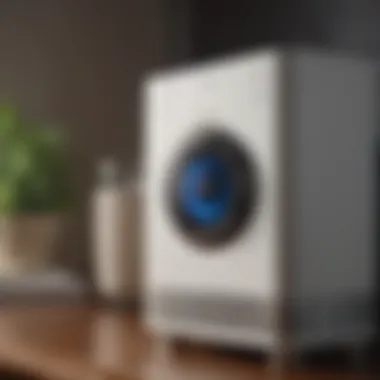Top Bedroom Air Purifiers for Healthier Sleep


Intro
Creating a sanctuary in our bedrooms is essential for fostering relaxation and restfulness. One crucial aspect of this serene environment is the quality of the air we breathe while we sleep. With many pollutants, allergens, and the ever-present particles in the atmosphere, investing in a top-tier air purifier tailored for bedroom use becomes increasingly important. Manufacturers have made great strides in technology and design, emphasizing efficient filtering systems to enhance indoor air quality. This article takes a thorough look at selected models and their features that stand out in today’s market.
To better inform your choices, we will touch on aspects like functionality, technological innovations, and how these aspects contribute to a healthier sleeping atmosphere. Keeping in mind the nuances that make air purifiers more suitable for bedrooms, like size, noise levels, and maintenance requirements, empowers buyers to make decisions that resonate with their unique lifestyles.
As we delve deeper, we will explore not just the mechanics but also the aesthetics—how the latest styles in air purifiers can seamlessly integrate into bedroom decor. Let's break down the most notable trending styles and color palettes in air purifiers and discuss how they can complement your personal space.
Trending Styles
Modern Minimalism
As modern living spaces evolve, the trend of minimalism continues to dominate bedroom aesthetics. Air purifiers that embody a sleek design align perfectly with this philosophy, blending function with form. These devices often come with clean lines, unobtrusive shapes, and neutral colors, ensuring they don’t detract from the overall decor.
Modern models like the Dyson Pure Cool stand out with their futuristic appearance and balance of style and functionality. They capture airborne particles while adding a touch of elegance to the room. This allows homeowners to enjoy clean air without compromising on design.
Cozy Rustic
Conversely, the cozy rustic approach draws on natural textures and earthy colors, focusing on warmth and comfort. Here, air purifiers crafted from wood or featuring natural finishes resonate with the overall theme. Coway AP-1512HH Mighty embodies this charm with its simplicity and organic appeal. Ideal for bedrooms furnished in wooden tones or soft fabrics, these purifiers provide a clean ambiance while blending seamlessly with the surrounding decor.
Color Palettes
Calming Neutrals
The color palette of any room can impact its atmosphere significantly. For bedrooms aiming for tranquility, calming neutral tones are the perfect choice. Devices in muted grays, soft whites, or beige can enhance that serene quality while promoting relaxation during sleep. Brands like Blueair focus on this color range, offering air purifiers that blend into the serene backdrop of your personal retreat.
Bold Accents
Alternatively, if you're one to embrace a pop of color, bold accents can serve as excellent conversation starters in the bedroom. Air purifiers with vibrant colors—such as Levoit Air Purifier, which comes in deep blues and rich reds—inject energy into a space. This dynamic interplay can invigorate the atmosphere, creating an engaging living space while still ensuring clean air around the clock.
The choice of the air purifier doesn’t just revolve around the functionality but also the style and aesthetics that reflect your personal taste, supporting your vision of a perfect bedroom.
Through a thoughtful exploration of styles and color schemes, this analysis forms the foundation for understanding the importance of air purifiers. We will now transition into specific features and technologies, focusing on how they contribute to a better indoor environment.
Understanding Indoor Air Quality
Indoor air quality is an often overlooked yet vital aspect of comfortable and healthy living. It plays a crucial role in our day-to-day well-being and can greatly affect various aspects of our lives—from sleep quality to respiratory health. Understanding this concept is essential for making informed choices about air purifiers, especially when it comes to our bedrooms where we spend a considerable amount of our time.
The Importance of Clean Air
Clean air is the breath of life, not just metaphorically. Breathing in fresh, pollutant-free air can significantly enhance one's overall well-being. Clean indoor air contributes to better focus, improved mood, and higher energy levels.
For anyone keen on creating a calm and serene environment, like in a bedroom, prioritizing clean air is a no-brainer. Dust, allergens, and chemicals can sneak in unnoticed, affecting our health day and night. Investing in good air purifiers can help combat these indoor threats tremendously.
Common Pollutants in Bedrooms
Bedrooms, being more enclosed spaces, can gather a mishmash of indoor pollutants over time. Identifying these pesky infiltrators is fundamental to improving air quality.
Dust and Dust Mites
Dust is not just a nuisance; it is a cocktail of dead skin cells, hair, and allergens. Dust mites, microscopic critters that thrive in our bedding and carpets, are particularly notorious. These little troublemakers contribute to allergic reactions and irritate many people's airways.
One distinctive aspect of dust mites is their living environment. They love humidity and warmth, perfect conditions found in a bedroom. To tackle this, regular vacuuming and using air purifiers with HEPA filters can work wonders. This filtering method can capture these mites, reducing their impact significantly.
Pet Dander
For pet owners, the air quality challenge intensifies with pet dander. This is tiny flecks of skin shed by cats, dogs, and other pets. It's very lightweight, floating around and provoking allergic reactions. The main feature of pet dander is its persistence; it can linger long after your furry friend has left the room.
In this article, discussing pet dander is important because it highlights a genuine concern for countless families. An effective air purifier can trap these particles, making a notable difference in creating a comfortable sleeping area is vital for allergy sufferers.
Volatile Organic Compounds (VOCs)
VOCs are another silent threat that can infiltrate your home. They emerge from household products like paints, cleaning supplies, and even some furniture. Their presence is particularly alarming as they can evaporate at room temperature, causing air quality to fluctuate without warning.


One unique feature of VOCs is their ability to cause health issues such as headaches and nausea, often without the victim being fully aware of the source. Discussing VOCs within the scope of air quality becomes essential for people keen on maintaining a healthy environment, especially in personal spaces like bedrooms. Devices equipped to handle VOCs will markedly improve the indoor air quality and personal comfort.
Health Impacts of Poor Air Quality
When indoor air quality takes a dip, the ripple effects can be feels across one's health spectrum. Poor air quality can trigger numerous problems that stretch from mild discomfort to severe health issues.
Respiratory Issues
Respiratory problems can be a direct byproduct of poor indoor air quality. Exposure to pollutants like dust, pet dander, and VOCs can facilitate breathing difficulties, even for those who are generally healthy. Symptoms can include recurrent coughing or even asthma attacks for sensitive individuals. Addressing air quality emerges as a must for safeguarding respiratory health, particularly among vulnerable groups such as children and the elderly.
Allergies
Inadequate levels of fresh air can also exacerbate allergies. People with allergies know that a stuffy room can lead to increased sneezing, itching, and discomfort. Allergens thrive in stagnant air, and without proactive methods to remove these particles, they’ll only multiply.
This discussion is critical, especially when examining the need for efficient air purifiers that can effectively deal with various allergens, contributing to a more peaceful sleeping environment.
Sleep Disturbances
The impact of poor indoor air quality on sleep disturbances cannot be emphasized enough. A bedroom filled with allergens can create a restless night full of tossing and turning. Lack of good air flow can lead to increased anxiety and a lower quality of sleep overall. Awareness of air purity directly correlates with improved sleep quality.
Each pollutant discussed contributes to an intertwined web of environmental challenges, affecting various aspects of daily life. Understanding these factors is essential to appreciate the need for effective air purification to create a sanctuary in our bedrooms.
"A breath of clean air can be more than refreshing; it’s fundamental to health and wellness; recognizing this is the first step in crafting a nurturing home environment."
Selecting the Right Air Purifier
When it comes to creating a peaceful sleeping environment, selecting the right air purifier is crucial. The kind of air purifier you choose can significantly impact how well you breathe at night, which in turn influences sleep quality. In this section, we'll explore essential features that help you make an informed decision while highlighting specific advantages of different aspects of air purifiers. This understanding is key for maintaining good health and ensuring that your bedroom remains a sanctuary for rest.
Key Features to Consider
Filter Types
When evaluating air purifiers, filter types stand out as an essential consideration. Purifiers typically use multiple filtration methods, but HEPA (High-Efficiency Particulate Air) filters are the most popular. These filters can capture at least 99.97% of particles that are 0.3 microns in size, which includes a good chunk of the dust and allergens floating around in your bedroom. The reliability of HEPA filters makes them a widely recommended choice in this guide.
Another option to look out for is activated carbon filters. While HEPA filters excel at capturing physical particles, activated carbon filters are crucial for eliminating odors and gases, such as volatile organic compounds (VOCs). One downside is that these filters usually need replacement more frequently than HEPA filters, resulting in additional costs over time.
In summary, the type of filter in an air purifier determines the range of pollutants it can remove. Choosing a model with both HEPA and activated carbon filters can offer a comprehensive solution to indoor air quality.
CADR Ratings
Clean Air Delivery Rate (CADR) ratings tell you how effectively an air purifier can clear the air in a room. Measured in cubic feet per minute (CFM), CADR is crucial in understanding whether a particular model is suitable for your space. The higher the CADR rating, the faster the purifier can remove pollutants, making it a significant factor to consider when selecting your device.
For example, if you have a smaller bedroom of about 150 square feet, you will want an air purifier with a CADR of at least 100 CFM. This ensures that the unit can cycle through the air quickly enough to make a noticeable difference in air quality. While a high CADR rating is beneficial, if the unit is much more powerful than needed, it might result in excessive energy consumption. Thus, balance is essential.
Noise Levels
Noise emissions are often a major concern for people buying air purifiers, especially for bedrooms where tranquility is paramount. The noise level is usually measured in decibels (dB), and it can range from whisper-quiet to more obtrusive sounds. Ideally, you want an air purifier that operates at less than 30 dB for a quiet night's sleep.
Many modern models come with a sleep mode, which significantly reduces noise while still maintaining effective air filtration. However, some purifiers might be noisy on higher settings, so it's essential to look into user reviews on the noise performance before settling on a model. Making sure your purifier offers satisfactory noise levels will go a long way in enhancing your sleep experience.
Assessing Room Size
To get the most out of your air purifier, understanding your room size is vital. Larger rooms naturally require devices that can handle more significant filtration needs. In contrast, smaller bedrooms can benefit from less powerful units without compromising air quality.
While selecting a purifier, pay attention to the manufacturer's recommended room size. If you go smaller than what the manufacturer recommends, you risk inefficient air filtration. This can lead to poor indoor air quality, which is precisely what you're trying to eliminate.
Energy Efficiency Considerations
An energy-efficient air purifier doesn't just save you money on your electricity bill; it also reduces your carbon footprint. When shopping, look for purifiers labeled as Energy Star compliant. These devices use less energy while maintaining optimal performance levels. Also, consider models with multiple fan speed settings, allowing for lower energy use when high power is unnecessary.
Overview of Top Rated Air Purifiers
Choosing the right air purifier for your bedroom is a decision that transcends mere aesthetics; it influences your health, comfort, and overall quality of life. The air we breathe directly impacts our well-being, particularly in spaces where we spend a significant amount of time, like our bedrooms. An effective air purifier doesn’t just eliminate particulates; it acts as a proactive measure against pollutants that could potentially disrupt restful sleep or exacerbate existing health issues.
Understanding the different types of air purifiers and their functionalities is crucial to making an informed decision. It’s not just about choosing a device that looks good on your bedside table; it’s about investing in your health, comfort, and peace of mind. The following sections will provide an overview of various top-rated air purifiers currently available, with particular emphasis on their unique features and benefits.


High-Efficiency Particulate Air (HEPA) Purifiers
HEPA purifiers are often considered the gold standard in air purification technologies. These devices can trap at least 99.97% of particulates that are 0.3 microns or larger in diameter. What grabs the attention of many is their ability to capture common indoor allergens such as dust, pollen, and pet dander effectively. This efficiency is important, especially for households with pets or occupants prone to allergies.
Moreover, HEPA purifiers are known for being low maintenance, and their filters often have a longer lifespan compared to alternatives. It’s essential to note, however, that while HEPA filters do an exceptional job of catching particles, they do not eliminate odors as effectively, which brings us to another type of air purifier.
Activated Carbon Purifiers
Activated carbon purifiers employ a different approach. They are especially adept at removing volatile organic compounds (VOCs), smoke, and odors, thanks to their porous nature that allows them to trap odorous particles. This feature makes them a popular choice among homeowners who are concerned about indoor pollution stemming from household products or cooking.
However, it’s worth mentioning that while activated carbon purifiers shine in odor control, they may not be as effective as HEPA purifiers in capturing fine particulates. Therefore, many homeowners opt for a combination of air purifiers to ensure a holistic approach to air quality.
Ionic Air Purifiers
Ionic air purifiers operate on a different principle—ionization. These devices release negatively charged ions into the air, which then attach to positively charged particles, causing them to cluster together and settle down or stick to nearby surfaces. This technology can effectively reduce airborne pollutants, including dust and smoke.
While ionic purifiers can be effective, they sometimes generate ozone, a gas that, in high concentrations, can be harmful to respiratory health. Therefore, it is crucial for users to weigh the benefits against the possible drawbacks when considering this type of air purifier.
In summary, selecting the right air purifier doesn’t merely boil down to cost or brand loyalty. It requires a deep understanding of your specific needs, room characteristics, and air quality concerns.
As we delve further into specific models in the following sections, keep in mind that your choice should bring not just cleanliness, but also a sense of well-being and protection within your personal sanctuary.
Detailed Reviews of Specific Models
When diving into the sea of air purifiers, it becomes crucial to focus on specific models that stand out for their functionality, user benefits, and overall performance. Detailed reviews play a pivotal role in informing consumers about the pros and cons of each model, helping prospective buyers navigate the often cluttered marketplace. By examining user experiences and conducting comparative analysis, it’s possible to highlight the unique features and effectiveness of selected air purifiers, ultimately guiding our readers toward an informed decision. Thus, the section will shed light on Model A, Model B, and Model C, illustrating how each model can cater to distinct needs and preferences in creating a healthier living space.
Model A: Features and Benefits
User Feedback
User feedback serves as a compass in the consumer world, guiding one’s choices in a manner that advertisements can’t always achieve. For Model A, reviewers often bring up its remarkable filtration system, which users claim significantly reduces allergens and dust levels. Many people, especially those with respiratory issues, appreciate how quickly they notice changes in air quality. An important characteristic of this model is its ultimate capability in reducing environmental irritants. This model tends to be a popular choice among those who prioritize clean air, thanks to a specific feature where its sensors can adjust operations based on detected pollutants. Though some users mentioned the initial cost being on the higher side, they often conclude that the investment pays off in improved well-being and comfort during sleep hours.
Comparative Analysis
Comparative analysis of Model A highlights its notable difference from other air purifiers on the market. What really stands out here is its smart technology integration, allowing users to control settings via a mobile app. This feature is especially beneficial for tech-savvy homeowners who crave convenience. In comparisons with rival models, it generally excels in Clean Air Delivery Rate (CADR), particularly in capturing larger and smaller particles, which is critical for bedrooms. Conversely, its energy consumption is something to keep in mind—though efficient, it may ramp up the electricity bill for continuous use.
Model B: Features and Benefits
User Feedback
When it comes to Model B, user feedback points to an overall solid performance, particularly appreciated by users with pets. Many reviews praise its capability in trapping pet dander and odors, which can be a game-changer for households where furry friends roam. Users often say it functions quietly, a plus for those looking for a noiseless operation, especially during nighttime. An interesting aspect to note is how this model features a user-friendly interface, making it approachable for users of various tech-savviness levels. However, a noted downside is the need for more frequent filter changes compared to other models, potentially leading to higher maintenance cost.
Comparative Analysis
In the comparative analysis, Model B frequently stands out for its excellent price-to-performance ratio. Its affordability makes it a top pick for family homes, especially when compared against pricier alternatives that may not offer significantly better results. The model competes well with others by combining effectiveness with straightforward features. While it is economical, its singular feature of using a combination of HEPA and carbon filters has shown notable results in combating allergens and airborne impurities, making it a well-rounded option for those looking to enhance bedroom air quality without breaking the bank.
Model C: Features and Benefits
User Feedback
Moving onto Model C, user feedback sheds light on its innovative design. Reviews often emphasize how its sleek look can blend nicely with bedroom decor, an essential feature for design-conscious users. People love its dual filtration method that targets not only dust and dander but also VOCs, a recurring concern in modern homes filled with synthetic materials. Users frequently mention an improved airflow as a key bonus, which seems to enhance overall comfort during sleep. However, it's notable that some customers have had issues with its durability, reporting that certain components may wear out faster than those of leading competitors.
Comparative Analysis
The comparative analysis of Model C reveals some intriguing insights. While it may not lead the pack in terms of noise level reduction, its efficiency in managing both particulate matter and gases is commendable. It consistently garners excellent reviews for its ability to cover larger room sizes, making it ideal for those with spacious bedrooms. Yet again, there’s the balancing act of performance versus price—that is, it offers significant features but might come at a price point that raises eyebrows for budget-conscious shoppers. The added ability to monitor air quality through an on-device display does add a touch of functionality, a point that many consumers appreciate for tangible insights into their environment.
Great consideration of user feedback and comparative aspects creates a well-rounded perspective when evaluating specific models. By carefully reviewing personal experiences alongside performance metrics, individuals seeking to enhance their indoor spaces can make decisions that resonate with their specific needs.
Maintenance and Care for Air Purifiers
Taking care of air purifiers is not just about keeping them looking neat; it's about optimizing their functionality and ensuring clean air in your bedroom. Just like a well-oiled machine, these devices require regular attention to maintain their efficiency and lifespan. Neglecting maintenance can lead to reduced performance, which defeats the purpose of investing in an air purifier in the first place. Therefore, staying on top of maintenance tasks is crucial for reaping the benefits they offer.
Regular Filter Replacement
Filters are at the heart of an air purifier's functionality. Typically, air purifiers use HEPA filters or activated carbon filters to capture particles and odors. Over time, these filters get clogged with dust, pet dander, and other pollutants, rendering them ineffective. This is where regular filter replacement plays a vital role.


Most manufacturers recommend checking the filters every few months, but it's wise to consult your specific model's manual for the best guidance. A good rule of thumb is to replace HEPA filters at least once a year, while activated carbon filters may need changing every six months. Keeping a close eye on filter conditions and marking it on your calendar helps maintain air quality.
- Visual Inspections: Regularly glance at the filters. If they look dirty or discolored, it's a sign they need replacing.
- Performance Indicator: Some models come with a reminder feature that alerts you when it’s time to swap out the filter.
Cleaning the Unit
While replacing filters is crucial, cleaning the entire unit is equally important. Dust can accumulate on the exterior and around the fan and vents, which can inhibit airflow and lead to ineffective purification. A simple wipe-down every couple of weeks can keep the unit in prime condition.
- Use a soft cloth to wipe the exterior. Avoid any harsh chemicals that could damage the surface.
- Make sure to turn off the device before cleaning to prevent any accidents.
- Carefully remove any dust from the vents and fan area using a vacuum cleaner with a brush attachment.
By maintaining cleanliness, you extend the air purifier’s lifespan and enhance its performance, allowing it to work its magic in offering you fresh air night after night.
Monitoring Performance
Lastly, keeping an eye on how well your air purifier is functioning is essential for ensuring you're getting the most out of your investment. Most modern air purifiers come outfitted with indicators that provide real-time feedback on air quality levels. This can be invaluable for understanding your bedroom’s air condition.
- Air Quality Indicators: Many devices come with lights that change color based on the current air quality status—green for good, yellow for moderate, and red for poor. Knowing this helps you understand when extra attention is needed.
- Noise Levels: Pay attention to changes in noise. If your air purifier is suddenly making odd sounds or is quieter than usual, it might indicate a problem that requires immediate attention.
Remember that a well-maintained air purifier not only improves air quality but also fosters a healthier living environment, especially in spaces where we spend significant time.
Investing time in maintenance may seem like a chore, but the dividends paid in improved health and comfort make it well worth the effort. By embedding these tasks into your regular home care routine, you're safeguarding your air quality and ensuring that your air purifier fulfills its purpose effectively.
Additional Considerations
When choosing the right air purifier for your bedroom, there are several aspects to weigh beyond just cost and brand reputation. These additional considerations play a crucial role in ensuring that the device you select effectively meets your needs and enhances your overall quality of life.
How Air Purifiers Affect Sleep
Air quality can have a significant impact on sleep. A bedroom that is filled with allergens, dust, and odors can lead to restless nights and poor sleep quality. When clean air circulates through your room, you might find it easier to drift off and stay asleep. Some purifiers even come equipped with a night mode, which dims lights and lowers operation noise. Thus, you don’t have to worry about any distraction while you’re trying to dream away the night.
Many users report that using air purifiers helps reduce symptoms of sinus issues or allergies, promoting a more restful sleep. It’s a breath of fresh air, literally! For instance, eliminating pet dander may significantly relieve nasal congestion that can interrupt sleep cycles.
Clean air is like a lullaby for your lungs.
Integrating Air Purifiers into Bedroom Design
While functionality is paramount, aesthetic appeal shouldn't be overlooked. Choosing an air purifier that compliments your bedroom decor can merge health with style seamlessly. Nowadays, models exist that blend in beautifully with furniture or even double as design features.
Before you make a selection, consider these aspects:
- Size and Placement: Placing a unit in the right location is vital for maximizing its efficiency. Avoid corners where airflow could be restricted.
- Color and Finish: Match the air purifier's color with other elements of your bedroom to create a harmonious look.
- Noise Levels: Look for models with low decibel ratings if you prefer peace and quiet. A bulky bass or high-pitched hum can be a sleep killer.
By thoughtfully placing an air purifier, you create not only a healthier environment but an inviting space that reflects your personal style.
Environmental Impact and Sustainability
In a world increasingly aware of environmental issues, the sustainability of your choice in an air purifier deserves attention. Opting for an energy-efficient model can save you money in the long run, whilst reducing your carbon footprint. Many purifiers are designed to consume less power without sacrificing performance, which ensures you breathe easy and save the planet at the same time.
Moreover, consider brands that use recyclable materials for their products and packaging. Supporting companies that prioritize sustainability is a win-win situation. You might even explore options with replaceable filters that are designed to last longer and can be disposed of more environmentally friendly.
- Energy Star Certification: Look for this label as it signifies adherence to strict energy efficiency guidelines.
- Chemical Emissions: Ensure the unit is certified to emit low levels of volatile organic compounds (VOCs).
Choosing a sustainable air purifier not only improves your bedroom's air quality but also contributes to a greener future.
Ending
The discussion surrounding air purifiers, specifically in the context of bedrooms, highlights their significant role in promoting better indoor air quality. As many already know, the conditions we create in our sleeping spaces directly influence our well-being. This article sheds light on several elements that contribute to making an informed choice in air purifiers.
Understanding the technical aspects—such as filter types and noise levels—alongside practical considerations like room size, allows for choices tailored to personal needs. Air purifiers not only reduce numerous pollutants, but they can also foster a serene and tranquil environment.
Investing in the right air purifier can have profound benefits, such as alleviating allergy symptoms or even improving sleep quality. With consistent use, these devices become part of the solution in battling everyday irritants, creating a haven where peace reigns.
Final Thoughts on Air Purifiers
Air purifiers provide more than just a clear atmosphere; they bring a sense of comfort and reassurance to daily life. As many individuals struggle with various sensitivities, knowing that there’s a device working tirelessly to filter out allergens and impurities can be a relief. The choice of the right air purifier is integral to enjoying not just good air quality, but an overall improved lifestyle.
When exploring options for air purifiers, consider features that matter most to you. Is quiet operation essential for restful sleep? Or do you prioritize energy efficiency to keep costs low? Regardless of priorities, thorough investigation into each model’s attributes goes a long way.
Encouragement for Informed Choices
Making the right decision involves gathering reliable information. It’s about piecing together various facets of air purification that contribute to a healthy indoor environment. When selecting an air purifier, do take the time to read user reviews and consider expert opinions. Every bit of research plays a part in understanding what will work best for your space.













